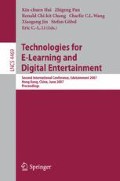Abstract
When designing product behavior, the designer often needs to communicate to experts in computer software and protocols. In present-day software engineering, formal specification methods such as the Universal Modeling Language have been widely accepted. Teaching design students these formal methods is non-trivial because most of design students often have difficulties in programming the behaviors of complex produces and systems. Instead of programming, this paper presents a technique, namely “acting-out”, for design students to master the formal methods. The experience shows that acting-out not only worked out very well as a teaching technique, but also showed the potential for bridging the processes of industrial design and software engineering.
Access this chapter
Tax calculation will be finalised at checkout
Purchases are for personal use only
Preview
Unable to display preview. Download preview PDF.
References
Grudin, J., Pruitt, J.: Personas, participatory design and product development: An infrastructure for engagement. In: Proceedings PDC, pp. 144–161 (2002)
van Welie, M., van der Veer, G.: Structured methods and creativity - a happy dutch marriage. In: Co-Designing 2000, Coventry, England, pp. 11–13 (2000)
Hu, J., Feijs, L.: IPML: Structuring distributed multimedia presentations in ambient intelligent environments. International Journal of Cognitive Informatics and Natural Intelligence, Special Issue on Ambient Intelligence and Art (to appear, 2007)
Hu, J.: Design of a Distributed Architecture for Enriching Media Experience in Home Theaters. Technische Universiteit Eindhoven (2006), ISBN:90-386-2678-8
Feijs, L., Hu, J.: Component-wise mapping of media-needs to a distributed presentation environment. In (COMPSAC 2004). The 28th Annual International Computer Software and Applications Conference, Hong Kong, China, pp. 250–257. IEEE Computer Society, Los Alamitos (2004), doi:10.1109/CMPSAC.2004.1342840
Feijs, L.M.G., Qian, Y.: Component algebra. Science of Computer Programming 42(2–3), 173–228 (2002)
Booch, G., Rumbaugh, J., Jacobson, I.: Unified Modeling Language for Object-Oriented Development (Version 0.9a Addendum). Rational Software Corporation (1996)
Taylor, D.A.: Object-Oriented Technology: A Manager’s Guide. Addison-Wesley, Reading (1990)
Martin, R.C.: Agile Software Development: Principles, Patterns, and Practices. Prentice-Hall, Englewood Cliffs (2002)
Buchenau, M., Suri, J.F.: Experience prototyping. In: Designing interactive systems: processes, practices, methods, and techniques, pp. 424–433. ACM Press, New York (2000)
Burns, C., Dishman, E., Verplank, W., Lassiter, B.: Actors, hairdos & videotape-informance design. In: CHI, pp. 119–120. ACM Press, New York (1994)
Buur, J., Jensen, M.V., Djajadiningrat, T.: Hands-only scenarios and video action walls: novel methods for tangible user interaction design. In: DIS, pp. 185–192. ACM Press, New York (2004)
Klooster, S., Overbeeke, C.: Designing products as an integral part of choreography of interaction: The product’s form as an integral part of movement. In: The 1st European workshop on Design and Semantics of Form and Movement, Newcastle, UK, pp. 23–55 (2005)
Ross, P., Keyson, D.V.: The case of sculpting atmospheres: towards design principles for expressive tangible interaction in control of ambient systems. Personal and Ubiquitous Computing 11(2), 69–79 (2007)
Author information
Authors and Affiliations
Editor information
Rights and permissions
Copyright information
© 2007 Springer Berlin Heidelberg
About this paper
Cite this paper
Hu, J., Ross, P., Feijs, L., Qian, Y. (2007). UML in Action: Integrating Formal Methods in Industrial Design Education. In: Hui, Kc., et al. Technologies for E-Learning and Digital Entertainment. Edutainment 2007. Lecture Notes in Computer Science, vol 4469. Springer, Berlin, Heidelberg. https://doi.org/10.1007/978-3-540-73011-8_48
Download citation
DOI: https://doi.org/10.1007/978-3-540-73011-8_48
Publisher Name: Springer, Berlin, Heidelberg
Print ISBN: 978-3-540-73010-1
Online ISBN: 978-3-540-73011-8
eBook Packages: Computer ScienceComputer Science (R0)

